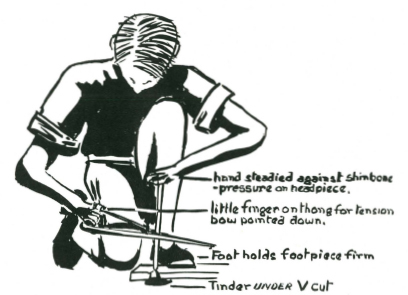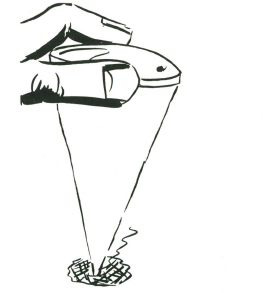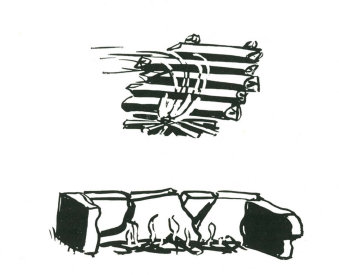
The underside of the headpiece has a shallow hole bored into it, and this is lubricated preferably with lead (graphite) from a pencil. A smear of fat will also serve as a lubricant, or if even this is not obtainable, wax from the ear can be used.
The correct body position for using the bow .and drill is to kneel on the right knee, with the ball of the’ left foot on the footpiece to hold it firmly to the ground. Place the lower end of the drill in the hole in the footpiece, and the top end of the drill in the hole in the underside of the headpiece.
The left hand holds the headpiece. The wrist of the left hand must be braced against the shin of the left leg. This will enable you to hold the headpiece perfectly steady. Actually the headpiece is a ‘bearing’ for the drill.
The bow is held in the right hand with the little and third finger outside the thong so that by squeezing these two fingers the tension of the thong can be increased.

The correct position to hold the various parts of the fireset.
To learn to use a firebow it is advisable to learn first to rotate the drill slowly. This is done by drawing the bow backwards and forwards. The thong round the drill will spin the drill. Only a light pressure is put on the headpiece. Very soon you will see smoke coming from the footpiece, and notice that a fine brown powder is being ground out. This is forming a dark ring round the edge of the hole. This powder is called ‘Punk.’
By examining it you can learn whether the woods you are using are suitable for firemaking.
The punk which will produce a glowing coal must feel slightly gritty when gently rubbed between the fingers, and then with more pressure it should rub gradually to a silky smoothness as soft as face powder.
This testing of the punk is extremely important. If you do not know for certain that the woods you are using are suitable for firelighting always make this test first.
When you consider that you have mastered control of the bow and drill you can start trying to get fire. Place a generous bundle of tinder under the V cut. When the drill is smoking freely and you have the ‘punk’ grinding out easily so that the V cut is full of it, put extra pressure on the headpiece and at the same time give twenty or thirty faster strokes with the bow. Lift the drill cleanly and quickly from the footpiece. Fold some of the tinder over lightly and blow gently into the V cut. If you see a blue thread of smoke continuing to rise, you can be sure you have a coal (you will probably see it glowing red). Fold the tinder completely over the footpiece, and continue blowing into the mass. The volume of smoke will increase, and a few quick puffs will make it burst into flame.
A tip given by some authorities is to put a little charcoal or gritty material into the hole in the footpiece. The claim is made that this enables more punk to be ground out, and the spark to be obtained more quickly.
Suitable woods for footpiece and drill, and this writer recommends that the same wood should be used for both parts, includes the willows and some of the non-resinous pines.
There are a few refinements which are worth knowing when you are making firebow set. These include the boring or burning of a hole for the thong at the tip and also through the handle of the bow. The end of thong at the tip of the bow has a thumb knot tied on the top side. The hole through the handle takes the long end of the thong, which is then wound round the handle in a series of half hitches. This hole in the handle enables you to adjust the ‘tension’ of the thong with greater accuracy.
A headpiece of shell or smooth grained stone with a hole in it is less liable to ‘burn’ than a headpiece of wood. Tinder should be carried in a waterproof bag.
FIRE FROM A MAGNIFYING GLASS
Almost everyone at some time or other has focused the sun’s rays concentrated by a magnifying glass (sometimes called a burning glass) onto a piece of paper or cloth to make it smoke. Lighting a fire with a magnifying glass calls for a ball of tinder with an inner core of extra fine material (see ‘tinders,’). Onto this inner core the sun’s rays are focused, and when the finer tinder is smoking freely, it simply requires blowing to produce flame. A concave mirror is even better than a magnifying glass. Powdered charcoal at the focal point will help the tinder take more easily.

FIRE BY AIR COMPRESSION
In parts of Southeast Asia native people make fire by the ingenious method of suddenly compressing air in a cylinder and thereby concentrating the heat in the air to a point when the heat is sufficient to ignite tinder. (They did this hundreds of years before Dr. Diesel thought of the same idea for his engine.)

Their fire-making sets, frequently a cylinder of bone or hollow bamboo, with a bone or wooden piston, are almost museum pieces today.
In use a small piece of tinder is inserted into a cavity in the lower end of the piston. The piston is placed in the cylinder and the flattened end opposite the piston head struck a smart blow with the palm of the hand, driving it suddenly down the cylinder. Compression of air with concentration of the heat it carries produces a small glowing coal in the tinder placed in the recess of the piston head.’ Frequently the jar of the blow will shake the tinder loose, so a ‘spark remover’ is used with the set to pull out the glowing tinder if it lodges in the cylinder.

The dimensions are roughly as follows:
Cylinder. 4” to 6” long. Outside diameter ¾” to 1”. Inside diameter about ½”.
Piston. 4” to 6” long, of which the shaft is 3” to 5”. Piston length ¾” to 1”. Diameter–to nicely fit the cylinder.
Recess at lower end of piston-about ¾” wide by ¾“ to 5/16” deep.
Piston shaft end is smooth and about 1” to 1½” diameter for striking with the palm of the hand.
BUILDING A FIRE
Combustion results when temperature is raised sufficiently high for the material to ignite. This is fire. Fire must have air, and you build your fire differently for different purposes.
FOR COOKING
A cooking fire must be a small fire, and one which is easily controlled. Often you need a ‘long’ fire because there are two or three billy cans, a griller and perhaps a frying pan, all of which must be on the fire at the one time.‘

Two green logs 6” or 8” thick placed about 12” apart will contain a cooking fire for you and make an excellent overnight fireplace.
A fire for cooking should be ‘low,’ with the quick heat of small wood. Too big a cooking fire will mean burnt fingers and burnt food. If the fire is too fierce, you will not be able to attend properly to the cookine of the food. There is a bush saying about cooking fires–‘The bigger the fire the bigger the fool.’ When laying a cooking fire ìt is a good plan to put a thicker stick in front of the fire. This will serve to rest your frying pan, and keep the heat from your hands; it will also help to contain the fire within the fireplace. A cooking; fire should always have a plentiful supply of small wood stacked conveniently near, so that you can feed the fire as the needs of the moment require.

The ideal way to build an open cooking fire.